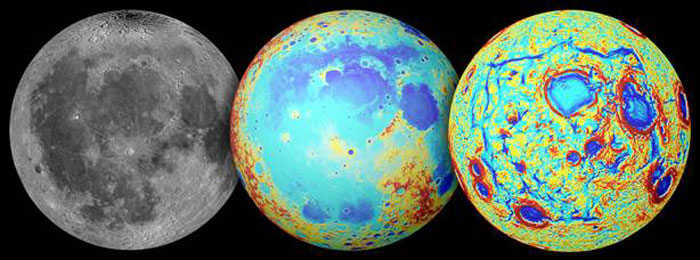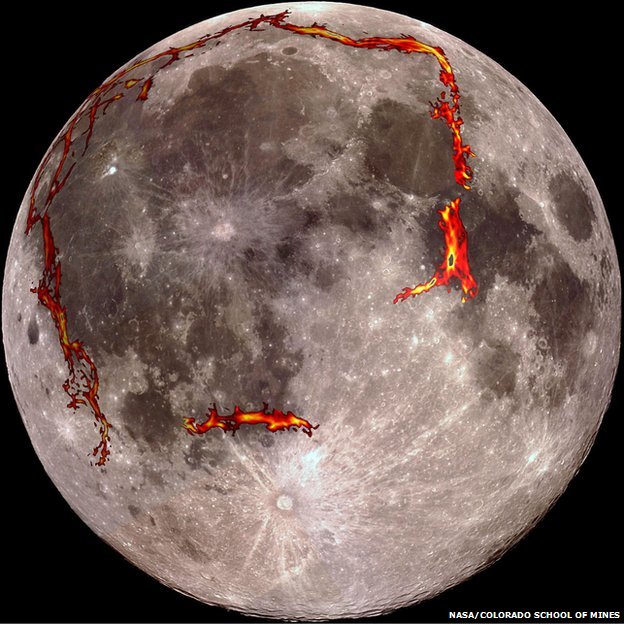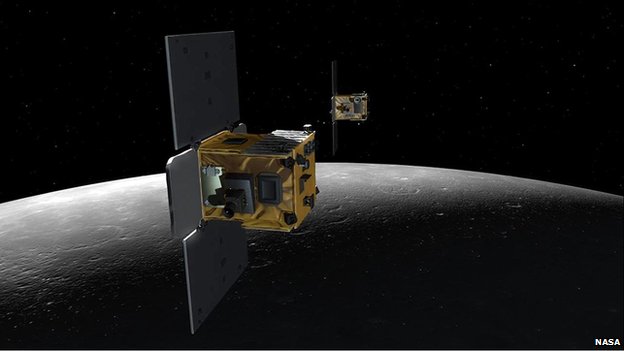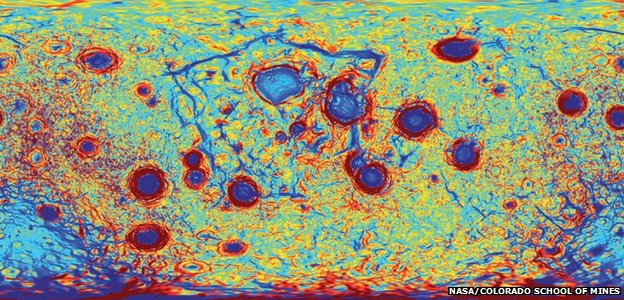.

Earth's moon as observed in visible light (left), topography (center, where red is high and blue is low), and the GRAIL gravity gradients (right). The Procellarum region is a broad region of low topography covered in dark mare basalt. The gravity gradients reveal a giant rectangular pattern of structures surrounding the region.
Image Credit: NASA/GSFC/JPL/Colorado School of Mines/MIT
Using data from NASA’s Gravity Recovery and Interior Laboratory (GRAIL), mission scientists have solved a lunar mystery almost as old as the moon itself.
Early theories suggested the craggy outline of a region of the moon’s surface known as Oceanus Procellarum, or the Ocean of Storms, was caused by an asteroid impact. If this theory had been correct, the basin it formed would be the largest asteroid impact basin on the moon. However, mission scientists studying GRAIL data believe they have found evidence the craggy outline of this rectangular region -- roughly 1,600 miles (2,600 kilometers) across -- is actually the result of the formation of ancient rift valleys.
"The nearside of the moon has been studied for centuries, and yet continues to offer up surprises for scientists with the right tools," said Maria Zuber, principal investigator of NASA's GRAIL mission, from the Massachusetts Institute of Technology, Cambridge. "We interpret the gravity anomalies discovered by GRAIL as part of the lunar magma plumbing system -- the conduits that fed lava to the surface during ancient volcanic eruptions."
The surface of the moon’s nearside is dominated by a unique area called the Procellarum region, characterized by low elevations, unique composition, and numerous ancient volcanic plains.
The rifts are buried beneath dark volcanic plains on the nearside of the moon and have been detected only in the gravity data provided by GRAIL. The lava-flooded rift valleys are unlike anything found anywhere else on the moon and may at one time have resembled rift zones on Earth, Mars and Venus. The findings are published online in the journal Nature.
Another theory arising from recent data analysis suggests this region formed as a result of churning deep in the interior of the moon that led to a high concentration of heat-producing radioactive elements in the crust and mantle of this region. Scientists studied the gradients in gravity data from GRAIL, which revealed a rectangular shape in resulting gravitational anomalies.
"The rectangular pattern of gravity anomalies was completely unexpected," said Jeff Andrews-Hanna, a GRAIL co-investigator at the Colorado School of Mines in Golden, Colorado, and lead author of the paper. "Using the gradients in the gravity data to reveal the rectangular pattern of anomalies, we can now clearly and completely see structures that were only hinted at by surface observations."
The rectangular pattern, with its angular corners and straight sides, contradicts the theory that Procellarum is an ancient impact basin, since such an impact would create a circular basin. Instead, the new research suggests processes beneath the moon’s surface dominated the evolution of this region.
Over time, the region would cool and contract, pulling away from its surroundings and creating fractures similar to the cracks that form in mud as it dries out, but on a much larger scale.
The study also noted a surprising similarity between the rectangular pattern of structures on the moon, and those surrounding the south polar region of Saturn’s icy moon Enceladus. Both patterns appear to be related to volcanic and tectonic processes operating on their respective worlds.
"Our gravity data are opening up a new chapter of lunar history, during which the moon was a more dynamic place than suggested by the cratered landscape that is visible to the naked eye," said Andrews-Hanna. "More work is needed to understand the cause of this newfound pattern of gravity anomalies, and the implications for the history of the moon."
Launched as GRAIL A and GRAIL B in September 2011, the probes, renamed Ebb and Flow, operated in a nearly circular orbit near the poles of the moon at an altitude of about 34 miles (55 kilometers) until their mission ended in December 2012. The distance between the twin probes changed slightly as they flew over areas of greater and lesser gravity caused by visible features, such as mountains and craters, and by masses hidden beneath the lunar surface.
The twin spacecraft flew in a nearly circular orbit until the end of the mission on Dec. 17, 2012, when the probes intentionally were sent into the moon’s surface. NASA later named the impact site in honor of late astronaut Sally K. Ride, who was America's first woman in space and a member of the GRAIL mission team.
GRAIL’s prime and extended science missions generated the highest resolution gravity field map of any celestial body. The map will provide a better understanding of how Earth and other rocky planets in the solar system formed and evolved.
The GRAIL mission was managed by NASA’s Jet Propulsion Laboratory (JPL) in Pasadena, California, for NASA's Science Mission Directorate in Washington. The mission was part of the Discovery Program managed at NASA's Marshall Space Flight Center in Huntsville, Alabama. GRAIL was built by Lockheed Martin Space Systems in Denver.
Quelle: NASA
.
Moon's hidden valley system revealed
Scientists have identified a huge rectangular feature on the Moon that is buried just below the surface.
The 2,500km-wide structure is believed to be the remains of old rift valleys that later became filled with lava.
Centred on the Moon's Procellarum region, the feature is really only evident in gravity maps acquired by Nasa's Grail mission in 2012.
But knowing now of its existence, it is possible to trace the giant rectangle's subtle outline even in ordinary photos.
Mare Frigoris, for example, a long-recognised dark stripe on the lunar surface, is evidently an edge to the ancient rift system.
"It's really amazing how big this feature is," says Prof Jeffery Andrews-Hanna.
"It covers about 17% of the surface of the Moon. And if you think about that in terms relative to the size of the Earth, it covers an area equivalent to North America, Europe and Asia combined," the Colorado School of Mines scientist told BBC News.
"When we first saw it in the Grail data, we were struck by how big it was, how clear it was, but also by how unexpected it was.
"No-one ever thought you'd see a square or a rectangle on this scale on any planet."
The study is reported in Nature magazine.
.

The full Moon as seen from the Earth, with the Procellarum border structure superimposed in red
So how was this extraordinary feature produced?
Andrews-Hanna and colleagues note that the Procellarum region contains a lot of naturally occurring radioactive elements, such as uranium, thorium and potassium.
On the early Moon, these would have heated the crust, which, when it cooled would have contracted.
Mare Frigoris is evidently an edge to the ancient rift valley system
This shrinking, they propose, would have ripped the surface, opening deep valleys. The geometry is the giveaway.
On Earth, cooling and contraction will preferentially produce hexagons containing 120-degree angles.
The famous Giant's Causeway in Northern Ireland is a classic example on the small scale, but even in bigger settings, such as in East Africa's rift valleys, geological lines tend to intersect in this way.
Procellarum's giant rectangle does the same, too - because the entire feature is draped over a sphere. This means the angles at the corners are wider than 90 degrees.
"What we're seeing is a clever trick of spherical geometry. For structures on this scale, a polygon with 120-degree angles at the corners actually has four sides instead of six," explained Prof Andrews-Hanna.
The team cannot tell when the rifting occurred, but the dating of Moon rocks brought back by Apollo would suggest the valleys were filled by volcanic lavas about 3.5 billion years ago.
.

Mare Frigoris is evidently an edge to the ancient rift valley system
.

Giant's Causeway: Cooling basaltic rock naturally fractures into hexagons

The Grail satellites sensed very subtle variations in the pull of gravity across the Moon's surface
The new study goes some way to resolving arguments over the origins of Procellarum, which looks different to other, more circular mare (dark regions) on the Moon's surface.
For these regions, big asteroid impacts were more important in sculpting their forms.
The study is also further proof of the value of the Grail mission, led from the Massachusetts Institute of Technology.
This comprised two, near-identical satellites that chased each other around the Moon over the course of a year.
They mapped changes in the pull of gravity as they flew over areas of differing mass.
Big mountains will have a different signal that is distinct to deep depressions, obviously. But the data also reveals those locations that have discrete rock types and densities.
In the case of Procellarum, the Grail pair sensed an excess of mass stemming from the presence of all the basaltic lava filling the rift valleys.
.

The feature stands out in this Mercator map projection of the changes in gravity
Quelle: BBC
4954 Views
